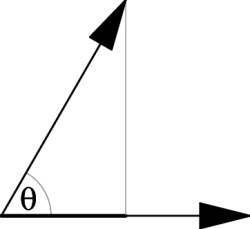You are here: start » book » sguidecontent » vectors
Vectors
A vector $\ww$ is an arrow in space, having both a magnitude and a direction. Examples of vectors include the displacement from one point to another, and your velocity when moving along some path.
The magnitude of $\ww$ is denoted by $|\ww|$, also written $||\ww||$. This is often casually called the “length” of $\ww$, but that is only technically correct if $\ww$ has units of length. The displacement between two points does indeed have a length, but to talk about your speed as being the “length” of your velocity vector is confusing at best.
A unit vector is a vector whose magnitude is $1$. Given any vector $\ww$, we get a unit vector by dividing $\ww$ by its magnitude $|\ww|$, that is, $\ww\over|\ww|$ is a unit vector.
Note that unit vectors are dimensionless!
If you divide your velocity by your speed, both measured in miles per hour, the magnitude of the result is just plain $1$, not “$1$ mph”. What information is left? The direction you are going. We therefore define the direction of a vector $\ww$ to be the unit vector in the same direction, which is just $\ww\over|\ww|$.
As is customary in many branches of science, we will denote unit vectors with a hat, rather than an arrow. We therefore write the unit vectors in the $x$, $y$, and $z$ directions respectively as $\ii$, $\jj$, and $\kk$. There are other common notations for these vectors. For instance, you may see $\ii$ written instead as any of $\iv$, $\aa_x$, $\ee_x$, or $\xhat$. You may also see the notation $w$ and $\Hat w$ for the magnitude and direction, respectively, of a given vector $\ww$, so that $w=|\ww|$ and $\Hat w={\ww\over |\ww|}$.
Any vector $\aa$ in 3 dimensions can of course be expressed in terms of its components. For instance, we might have $\aa = 2\,\ii + 3\,\jj + 4\,\kk$. But it is important to think of vectors as arrows in space, rather than as a list of 3 components. While these points of view are equivalent, the former is more geometric. One of the goals of this course is to develop this geometric intuition so that you can use it in applications. It is in part for this reason that, unlike many texts, we always include the basis vectors $\{\ii,\jj,\kk\}$ when referring to the (Cartesian) components of a vector; we never write “$\aa=\langle 2,3,4 \rangle$”.
For an arbitrary vector $\ww$ with unknown (Cartesian) components, we write $$\ww = w_x\,\ii + w_y\,\jj + w_z\,\kk$$ Note the use of subscripts to denote the components; these subscripts do not denote partial differentiation, and in fact for this reason we never use subscripts to denote derivatives.
Dot Product
The dot product is fundamentally a projection, as shown in the figure above. In the figure, the length of the heavy line segment represents the component of $\vv$ in the $\ww$ direction. This defines the dot product of $\vv$ with $\ww\over|\ww|$; multiplying through by $|\ww|$ and using some triangle trigonometry leads to the geometric formula $$ \vv\cdot\ww = {|\vv| |\ww| \cos\theta} $$ for the dot product of $\vv$ and $\ww$. (Projecting $\ww$ onto $\vv$ instead leads to the same result.) % An immediate consequence of this formula is that the dot product of a vector with itself gives the square of its magnitude, that is $$ \vv\cdot\vv = |\vv|^2 $$ In particular, taking the “square” of any unit vector yields 1, for example $$ \ii\cdot\ii = 1 $$ Furthermore, since $\cos{\pi\over2}=0$, it follows immediately from the geometric definition that two vectors are orthogonal if and only if their dot product vanishes, that is $$ \vv\perp\ww \Longleftrightarrow \vv\cdot\ww = 0 $$
It is easy to see that the geometric formula reduces to the standard component form of the dot product. For example, if $\vv=v_x\,\ii+v_y\,\jj$ and $\ww=w_x\,\ii+w_y\,\jj$, then \begin{eqnarray*} \vv\cdot\ww &=& (v_x\,\ii+v_y\,\jj)\cdot(w_x\,\ii+w_y\,\jj) \\ &=& v_x w_x \,\ii\cdot\ii + v_y w_y \,\jj\cdot\jj + v_x w_y \,\ii\cdot\jj + v_y w_x \,\jj\cdot\ii \\ &=& v_x w_x + v_y w_y \end{eqnarray*} The dot product of a vector with itself reduces to the Pythagorean theorem when written out in terms of components, for example $$ \vv\cdot\vv = |\vv|^2 = v_x^2 + v_y^2 $$
Note that in the above computation we simply “multiplied out” the original expression in terms of components, then used the multiplication table \begin{eqnarray*} \ii\cdot\ii = 1 = \jj\cdot\jj \\ \ii\cdot\jj = 0 = \jj\cdot\ii \end{eqnarray*}
This is a useful strategy which you are encouraged to practice.
A good test of your understanding of the dot product is try to use it to find the angle between the diagonal of a cube and one of its edges, or the angle between two diagonals.
